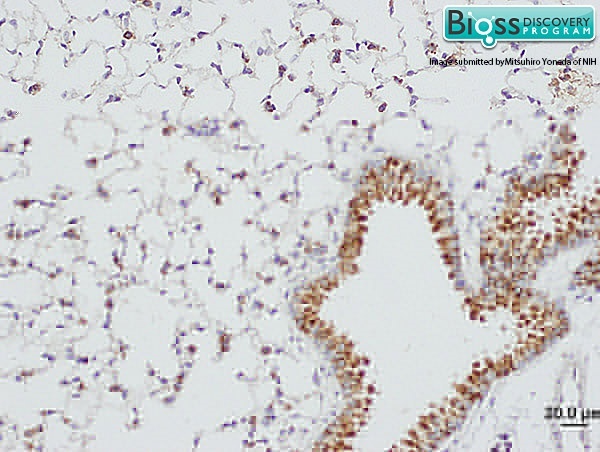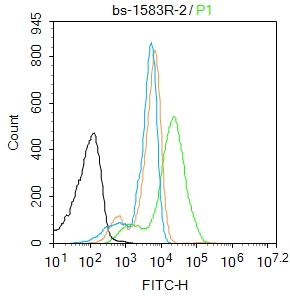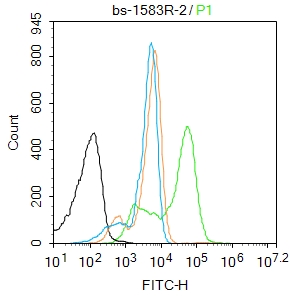
Rabbit Anti-SFTPD antibody
SFTPD surfactant protein D; pulmonary surfactant-associated glycoprotein D; COLEC 7; COLEC7; Collectin7; PSP D; PSPD; Pulmonary surfactant apoprotein; Pulmonary surfactant associated protein D; SFTP 4; SFTP4; SFTPD; SP D; Surfactant associated protein pul
View History [Clear]
Details
Product Name SFTPD Chinese Name 肺表面活性蛋白D抗体 Alias SFTPD surfactant protein D; pulmonary surfactant-associated glycoprotein D; COLEC 7; COLEC7; Collectin7; PSP D; PSPD; Pulmonary surfactant apoprotein; Pulmonary surfactant associated protein D; SFTP 4; SFTP4; SFTPD; SP D; Surfactant associated protein pulmonary 4; Surfactant pulmonary associated protein D; SFTPD_HUMAN; Pulmonary surfactant-associated protein D; PSP-D; SP-D; Collectin-7; Lung surfactant protein D. literatures Research Area Tumour immunology Immunogen Species Rabbit Clonality Polyclonal React Species Human, Mouse, (predicted: Rat, Dog, ) Applications ELISA=1:5000-10000 IHC-P=1:100-500 IHC-F=1:100-500 Flow-Cyt=2ug/Test IF=1:100-500 (Paraffin sections need antigen repair)
not yet tested in other applications.
optimal dilutions/concentrations should be determined by the end user.Theoretical molecular weight 41kDa Cellular localization Secretory protein Form Liquid Concentration 1mg/ml immunogen KLH conjugated synthetic peptide derived from human SP-D: 301-375/375 Lsotype IgG Purification affinity purified by Protein A Buffer Solution 0.01M TBS(pH7.4) with 1% BSA, 0.03% Proclin300 and 50% Glycerol. Storage Shipped at 4℃. Store at -20 °C for one year. Avoid repeated freeze/thaw cycles. Attention This product as supplied is intended for research use only, not for use in human, therapeutic or diagnostic applications. PubMed PubMed Product Detail Surfactant protein D contributes to the lung's defense against inhaled microorganisms. It's a calcium ion dependent carbohydrate binding protein and is structurally similar to other C type mammalian lectins, such as conglutinin and SPA. It has a molecular size of approximately 37-43kDa in its reduced state, 620kDa in non dissociating conditions. Surfactant protein D enhances the production of oxygen radicals by rat alveolar macrophages and regulates some actions of SPA, which is the most abundant surfactant protein. Surfactant protein D is synthesized and secreted by alveolar epithelial type II cells.
Function:
Contributes to the lung's defense against inhaled microorganisms. May participate in the extracellular reorganization or turnover of pulmonary surfactant. Binds strongly maltose residues and to a lesser extent other alpha-glucosyl moieties.
Subunit:
Oligomeric complex of 4 set of homotrimers.
Subcellular Location:
Secreted, extracellular space, extracellular matrix. Secreted, extracellular space, surface film.
Post-translational modifications:
The N-terminus is blocked.
Hydroxylation on proline residues within the sequence motif, GXPG, is most likely to be 4-hydroxy as this fits the requirement for 4-hydroxylation in vertebrates.
Similarity:
Belongs to the SFTPD family.
Contains 1 C-type lectin domain.
Contains 1 collagen-like domain.
SWISS:
P35247
Gene ID:
6441
Database links:Entrez Gene: 6441 Human
Entrez Gene: 20390 Mouse
Omim: 178635 Human
SwissProt: P35247 Human
SwissProt: P50404 Mouse
Unigene: 253495 Human
Unigene: 1321 Mouse
Unigene: 11348 Rat
Product Picture
Primary Antibody (green line): Rabbit Anti-SFTPD antibody (SL1583R)
Dilution: 2μg /10^6 cells;
Isotype Control Antibody (orange line): Rabbit IgG .
Secondary Antibody : Goat anti-rabbit IgG-FITC
Dilution: 1μg /test.
Protocol
The cells were fixed with 4% PFA (10min at room temperature)and then permeabilized with 0.1% PBST for 20 min at room temperature. The cells were then incubated in 5%BSA to block non-specific protein-protein interactions for 30 min at room temperature .Cells stained with Primary Antibody for 30 min at room temperature. The secondary antibody used for 40 min at room temperature. Acquisition of 20,000 events was performed.Blank control:THP-1.
Primary Antibody (green line): Rabbit Anti-SFTPD antibody (SL1583R)
Dilution: 2μg /10^6 cells;
Isotype Control Antibody (orange line): Rabbit IgG .
Secondary Antibody : Goat anti-rabbit IgG-FITC
Dilution: 1μg /test.
Protocol
The cells were fixed with 4% PFA (10min at room temperature)and then permeabilized with 0.1% PBST for 20 min at room temperature. The cells were then incubated in 5%BSA to block non-specific protein-protein interactions for 30 min at room temperature .Cells stained with Primary Antibody for 30 min at room temperature. The secondary antibody used for 40 min at room temperature. Acquisition of 20,000 events was performed.Blank control:THP-1.
Primary Antibody (green line): Rabbit Anti-SFTPD antibody (SL1583R)
Dilution: 2μg /10^6 cells;
Isotype Control Antibody (orange line): Rabbit IgG .
Secondary Antibody : Goat anti-rabbit IgG-FITC
Dilution: 1μg /test.
Protocol
The cells were fixed with 4% PFA (10min at room temperature)and then permeabilized with 0.1% PBST for 20 min at room temperature. The cells were then incubated in 5%BSA to block non-specific protein-protein interactions for 30 min at room temperature .Cells stained with Primary Antibody for 30 min at room temperature. The secondary antibody used for 40 min at room temperature. Acquisition of 20,000 events was performed.
Bought notes(bought amounts latest0)
No one bought this product
User Comment(Total0User Comment Num)
- No comment





 +86 571 56623320
+86 571 56623320
 +86 18668110335
+86 18668110335

